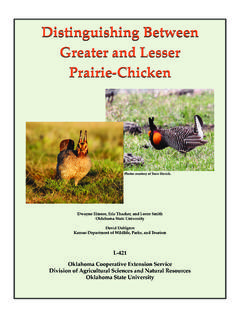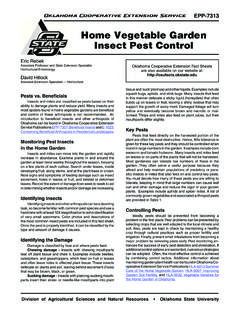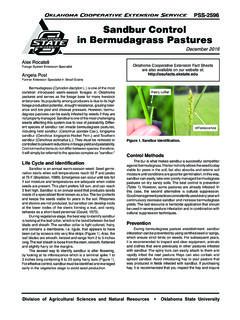Transcription of Growing Strawberries in the Home Garden
1 Division of Agricultural Sciences and Natural Resources Oklahoma State UniversityJulia WhitworthSmall Fruits Specialist Strawberries can be grown throughout Oklahoma, and they are the number one fruit crop for home plant-ings. Strawberries may also be grown as a cash crop in large home plantings. Strawberries are a versatile, highly nutritious fruit. One cup of fresh berries supplies more than the recom-mended daily adult requirement for Vitamin C. You should be able to harvest at least a quart of berries per five feet of row, if good cultural practices are followed. Usually, an initial planting of about 125 plants will provide plenty of fresh fruit and enough for freezing or preserving for a family of four. Before decid-ing to plant Strawberries , consider:1. site selection;2. plant selection;3. site preparation,4. propagation and planting;5.
2 General care, including fertilization, renovation, and irrigation;6. mulching;7. harvesting; and8. pest Selection The most successful strawberry planting receives full sun most of the day. Shady locations promote more vegetative growth, but yield few fruit. Shady locations are usually wetter than sunny sites, and therefore have greater disease problems. Plants stressed by drought have more disease problems and a lower yield than Strawberries that have received adequate water. Irrigation water should be available to help the plants survive dry periods throughout the year. Strawberries do best when grown in soil with a pH range of to Avoid planting in low areas because they are often prone to late spring frost. The site should not have been used for any kind of berries, tomatoes, potatoes, or peppers prior to planting new Strawberries .
3 This helps prevent disease problems, such as tomato ringspot virus and root Selection While there are many strawberry varieties from which to choose (Table 1), the performance of any one variety is greatly influenced by local Growing conditions and climate. When choosing a strawberry variety, it is important to consider the following:1. Select varieties adapted to your region. All of the varieties listed in this fact sheet are recommended for Accept only healthy-looking, certified virus-free Purchase plants from an established nursery and place orders as early as the nurseries will take them. Be sure to specify a delivery Most Strawberries will produce good crops if only one variety is planted. However, Spring Giant and Apollo are exceptions and should be planted within 25 feet of another variety for pollination. It is usually better to plant more than one variety.
4 A disease or frost is less likely to devastate your entire planting if you have several The fruiting season can be extended by planting varieties that ripen at different Cooperative Extension Fact Sheets are also available on our website at: Strawberries in the Home GardenOklahoma Cooperative Extension Service6214-2 Figure 1. Planting depth for Strawberries . A correct. B too shallow. This plant will dry out and die. C too deep. This plant will rot. A B C6. Consider the preservation quality and disease and insect resistance of the Choose varieties that you like. Some people like sweet berries, while others prefer tart Choose varieties that bloom when you want them to. June-bearing varieties are the most successful in Oklahoma. They produce a single crop each year in early May to mid-June, depending upon the weather and location.
5 June-bearers are divided into early-, mid-, and late-season varieties. Early-season varieties ripen in early May to mid-June. Mid-season varieties ripen in mid-May to mid-June. Late-season varieties ripen in late May to mid-June. Everbearers produce berries mid-May to mid-June, a few during the summer, and again in the fall. Fruit size and quality may not be as good as it is in other varieties, and total yield is often lower than that of June-bearers. Tribute and Tristar are everbearing varieties known as day-neutral cultivars, which are not recommended for Oklahoma. Some varieties, such as Tennessee Beauty, are listed as June-bear-ers by some sources and everbearers by Preparation If the site is in grass sod, wait one year before planting Strawberries . Use that year to kill grass and grubs, and to build the beds and provide extra drainage, if needed.
6 Have the soil tested several months before planting Strawberries . A soil sample can be collected and taken to the local OSU County Extension Office. See OSU Extension Fact Sheet PSS-2207 How to Get a Good Soil Sample for further information. Till the soil to provide a weed-free planting area. Keep in mind that beds should be narrow enough for easy picking usually not more than three feet wide. Organic matter, such as straw, manure, peat moss, or compost, can be added by plowing or tilling it into the soil several weeks before plants are set. Two to three weeks before planting, mix the recommended fertilizer and lime into the soil. Allow rainfall to settle the beds or use and Planting Strawberries are propagated by removing rooted runners from the mother plants and placing them in a new strawberry bed. Patented varieties may not be legally propagated either for expanding your plantings or for sale.
7 February 1 to March 20 is the recommended time for planting Strawberries in Oklahoma gardens. In the southeastern third of the state, plants may be set in the fall (October to mid-November). These plants will have a more extensive root system by spring and will be more vigorous producers of runner plants than plants set in February or March. Adequate soil moisture must be present during the winter months for good root de-velopment. Plants should not be set during dry windy conditions or if extremely cold weather is predicted during the following few days. Before planting, remove all but two or three of the most vigorous leaves from the plants. Plant the straw-berries to feet apart, depending on the vigor of the variety. Since the strawberry has the potential to produce 30 to 50 runner plants the first year of growth, this distance will allow plants to develop runners in the 6214-3row, while keeping the middle between the rows free of plants.
8 Ask your nursery representative for recommen-dations on plant spacing for the varieties you choose. Plant the Strawberries so that the crowns (where the leaves arise) are even with the ground surface after the soil has been firmed around the roots (Figure 1). This is very important, because plants set too deeply will rot and plants set too shallowly will dry out and die. Spread the roots out somewhat in the planting hole. Pack the soil firmly enough to hold the plant in the ground if you tug on a leaf, but not so firmly as to crush the plants. If you use a hand trowel to plant the Strawberries , push it about six inches into the prepared soil, and then pull it forward to open the hole. Put the plant into the hole at the proper depth and remove the trowel. Then, close the hole by placing the trowel in front of the plant and pulling the trowel forward to firm the soil.
9 After set-ting, give each plant at least a pint of water. Do not allow plants to become dry during the plant-ing operation. As each bundle of plants is opened, place the plants in a container with just enough water to keep the roots wet. Planting may be easier if the roots are trimmed slightly with scissors or a sharp knife so that they fit more easily into the hole. An irrigation system such as leaky pipe or other drip irrigation is recommended in order to lessen disease problems associated with wet foliage. These systems also conserve water that can be lost through evapora-tion and CareFirst Year During the summer, runner plants form from mother plants and take root. In the fall, plants build up food re-serves and form fruit buds for the next year s crop. The plants must be kept healthy for the best development of new plants and fruit buds.
10 The strawberry plant is shallow-rooted and requires frequent watering after transplanting. If there is little or no rainfall within any two week period of spring or sum-mer, enough water should be applied to wet the soil to a depth of 12 inches. This will usually require about one inch of applied water. Try to maintain a row width of 18 to 24 inches. Cultivation and hoeing aid in weed and grass control, which is very important in strawberry care. Cultivation helps keep runner plants within the allotted row area and permits easier rooting of runner plants. Chemical herbicides may be used as an aid in weed control, but their use is not recommended because they can dam-age strawberry plants. For more information on weed control in Strawberries , see OSU Extension Fact Sheet HLA-6239 Weed Management in Small Fruit Crops. Between August 15 and September 15, broadcast pounds of ammonium nitrate per 100 feet of row.
















